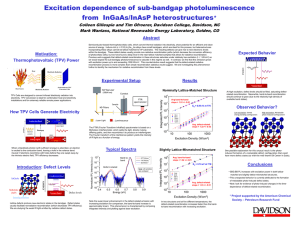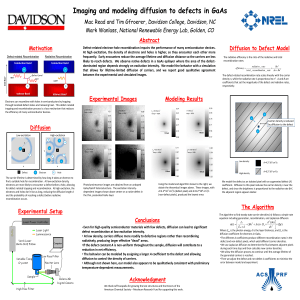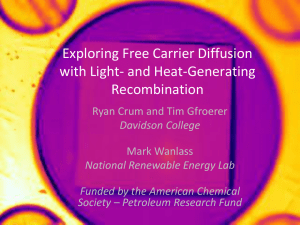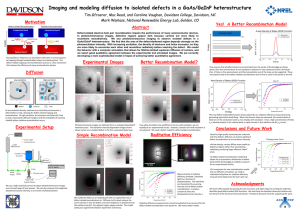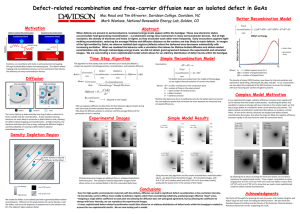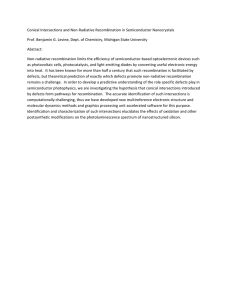Defect-related recombination and free-carrier diffusion near an isolated defect in... - Motivation Davidson College, Davidson, NC
advertisement
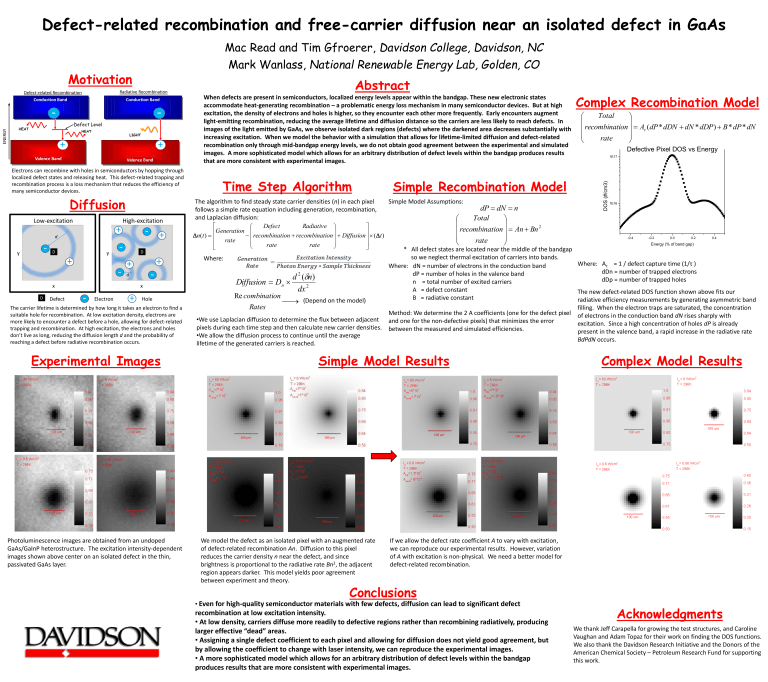
Defect-related recombination and free-carrier diffusion near an isolated defect in GaAs Mac Read and Tim Gfroerer, Davidson College, Davidson, NC Mark Wanlass, National Renewable Energy Lab, Golden, CO Radiative Recombination Defect-related Recombination Conduction Band Conduction Band ENERGY - Defect Level HEAT HEAT LIGHT + + Valence Band Valence Band Electrons can recombine with holes in semiconductors by hopping through localized defect states and releasing heat. This defect-related trapping and recombination process is a loss mechanism that reduces the efficiency of many semiconductor devices. Diffusion Low-excitation High-excitation + d - y D y + - + - D Defect - d x D + + x - Electron + Hole The carrier lifetime is determined by how long it takes an electron to find a suitable hole for recombination. At low excitation density, electrons are more likely to encounter a defect before a hole, allowing for defect-related trapping and recombination. At high excitation, the electrons and holes don’t live as long, reducing the diffusion length d and the probability of reaching a defect before radiative recombination occurs. Abstract When defects are present in semiconductors, localized energy levels appear within the bandgap. These new electronic states accommodate heat-generating recombination – a problematic energy loss mechanism in many semiconductor devices. But at high excitation, the density of electrons and holes is higher, so they encounter each other more frequently. Early encounters augment light-emitting recombination, reducing the average lifetime and diffusion distance so the carriers are less likely to reach defects. In images of the light emitted by GaAs, we observe isolated dark regions (defects) where the darkened area decreases substantially with increasing excitation. When we model the behavior with a simulation that allows for lifetime-limited diffusion and defect-related recombination only through mid-bandgap energy levels, we do not obtain good agreement between the experimental and simulated images. A more sophisticated model which allows for an arbitrary distribution of defect levels within the bandgap produces results that are more consistent with experimental images. Time Step Algorithm The algorithm to find steady state carrier densities (n) in each pixel follows a simple rate equation including generation, recombination, and Laplacian diffusion: Simple Recombination Model Simple Model Assumptions: dP dN n Total 2 recombination An Bn rate Defect Radiative Generation n(t ) recombination recombination Diffusion (t ) rate rate rate Total recombination A (dP * dDN dN * dDP ) B * dP * dN rate Defective Pixel DOS vs Energy 1E17 1E16 -0.4 -0.2 0.0 0.2 0.4 Energy (% of band gap) * All defect states are located near the middle of the bandgap so we neglect thermal excitation of carriers into bands. Where: Where: Aτ = 1 / defect capture time (1/τ ) Where: dN = number of electrons in the conduction band dDn = number of trapped electrons 2 dP = number of holes in the valence band d (n) dDp = number of trapped holes n = total number of excited carriers Diffusion Dn 2 dx A = defect constant The new defect-related DOS function shown above fits our Re combination B = radiative constant radiative efficiency measurements by generating asymmetric band (Depend on the model) Rates filling. When the electron traps are saturated, the concentration Method: We determine the 2 A coefficients (one for the defect pixel of electrons in the conduction band dN rises sharply with •We use Laplacian diffusion to determine the flux between adjacent and one for the non-defective pixels) that minimizes the error excitation. Since a high concentration of holes dP is already pixels during each time step and then calculate new carrier densities. between the measured and simulated efficiencies. present in the valence band, a rapid increase in the radiative rate •We allow the diffusion process to continue until the average BdPdN occurs. lifetime of the generated carriers is reached. Experimental Images Simple Model Results 100 µm 100 µm 100 µm 100 µm 100 µm Photoluminescence images are obtained from an undoped GaAs/GaInP heterostructure. The excitation intensity-dependent images shown above center on an isolated defect in the thin, passivated GaAs layer. Complex Recombination Model DOS (#/cm3) Motivation Complex Model Results 100 µm 100 µm 100 µm We model the defect as an isolated pixel with an augmented rate of defect-related recombination An. Diffusion to this pixel reduces the carrier density n near the defect, and since brightness is proportional to the radiative rate Bn2, the adjacent region appears darker. This model yields poor agreement between experiment and theory. If we allow the defect rate coefficient A to vary with excitation, we can reproduce our experimental results. However, variation of A with excitation is non-physical. We need a better model for defect-related recombination. Conclusions • Even for high-quality semiconductor materials with few defects, diffusion can lead to significant defect recombination at low excitation intensity. • At low density, carriers diffuse more readily to defective regions rather than recombining radiatively, producing larger effective “dead” areas. • Assigning a single defect coefficient to each pixel and allowing for diffusion does not yield good agreement, but by allowing the coefficient to change with laser intensity, we can reproduce the experimental images. • A more sophisticated model which allows for an arbitrary distribution of defect levels within the bandgap produces results that are more consistent with experimental images. Acknowledgments We thank Jeff Carapella for growing the test structures, and Caroline Vaughan and Adam Topaz for their work on finding the DOS functions. We also thank the Davidson Research Initiative and the Donors of the American Chemical Society – Petroleum Research Fund for supporting this work.
